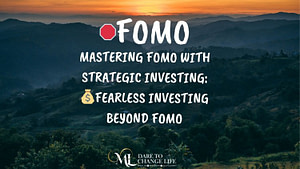
Understanding FOMO
FOMO is a powerful emotional response to observing others succeeding from some kind of efforts.
For example, when you see others profiting from investing financial markets, you may feel like you’re missing out on the opportunity of a lifetime.
The NASDAQ’s impressive performance and tech giants like Apple or NVIDIA reaching new highs this year can trigger this fear.
But it’s essential to remember that investing based on emotions can lead to impulsive decisions and potential financial pitfalls.
The Danger of Chasing Highs
Chasing after high-flying stocks and trendy investments can be tempting, especially when you see others reaping huge gains.
However, this FOMO-driven approach can be a double-edged sword.
Investing in assets without thorough research and understanding of their fundamentals can lead to significant losses when the tides turn.
The Role of Strategic Investing
Let’s explore a more prudent approach to investing—strategic investing.
Strategic investing involves thoughtful planning, diversification, and a focus on your long-term goals.
Rather than getting swept up in short-term market movements, strategic investors aim to build a well-balanced portfolio that can weather market fluctuations.
Building a Strategic Investment Plan
Now that you understand the dangers of FOMO and the allure of chasing high-flying stocks, let’s explore creating a robust strategic investment plan that can help safeguard your financial future.
In context of the current economic landscape and the recent market fluctuations, strategic investing approach becomes even more essential.
As we witnessed during the first half of 2023, tech giants like Apple and AI-driven Semiconductor Company like NVIDIA achieved astonishing milestones.
However, strategic investors understand that a single sector’s performance doesn’t define the entire market.
Instead of being swept up by short-term enthusiasm, they stay true to their long-term objectives.
Building a strategic investment plan requires a comprehensive understanding of your financial goals, your risk tolerance, and your investing time horizon.
6 Key Components of a Well-crafted Investment Strategy:
1. Have Clear Financial Goals
The foundation of any strategic investment plan is setting clear financial goals.
Are you saving for retirement? Funding your children’s education? Or planning a major purchase?
Get clarity about your top financial goals.
Each goal will have a different time frame and risk profile, which should inform your investment decisions.
For example, my goal was to be financially free BEFORE my retirement age.
2. Assess Your Risk Tolerance
Risk tolerance plays a crucial role in shaping our investment choices.
It’s essential to honestly assess how comfortable you are with market volatility.
Understanding how much volatility you can stomach will help determine the right asset allocation for your portfolio.
A high-risk portfolio might deliver substantial returns during bullish times, but it could also lead to significant losses during downturns.
With age, your risk tolerance factor is especially an important one to be mindful of.
I am a risk-taker by nature but I’m much more conservative now with my investment strategies.
3. Incorporate Strategic Asset Allocation and Diversification
Asset allocation is the art of spreading your investments across different asset classes, such as stocks, bonds, real estate, precious metals, and cash.
Diversification further minimizes risk by diversifying your investments within each asset class.
By diversifying, you avoid putting all your eggs in one basket. This way, the performance of any single investment won’t have a disproportionate impact on your overall portfolio. Strategic investors carefully weigh their asset allocation to align with their goals and risk tolerance.
4. Do Your Own Research and Due Diligence
Strategic investing involves thorough research and due-diligence. It means going beyond flashy headlines and digging into company fundamentals’ performance charts, economic indicators, and market trends.
Be cautious of financial media hype of market movements. Relying on knee-jerk reactions without your own proper due-diligence can be a recipe for disaster.
5. Embrace Patience and Discipline
Patience and discipline are virtues that can set strategic investors apart from the crowd.
Markets will inevitably have ups and downs, and test your nerves at times…
Reacting impulsively can lead to VERY costly mistakes.
Staying the course and not giving in to emotional impulses are keys to long-term successful investing.
Strategic investors understand that time is on their side, and they let their investments grow and compound over the long haul.
I can personally attest to this important aspect of strategic investing.
At first, I felt scared and overwhelmed seeing the fluctuations in my investment portfolio. Now I’m much more grounded and calm because I practice disciplined resolves.
6. Seek Guidance and Professional Advice
While strategic investing empowers individuals to stay informed and to take control of their financial future, seeking advice from qualified financial professionals – financial coaches, advisers, planners – can be invaluable.
Financial professionals can help you tailor investment strategies to your unique needs, provide expert insights, and act as a source of support and guidance during uncertain economic times like we experience now.
“THE BIG LOSS”
Embracing strategic investing also aligns perfectly with protecting yourselves from the dreaded “big loss.”
When you come from a place of FOMO, you are destined to REACT, CHASE, and DOUBT yourself instead of RESPONDING, ATTRACTING, and BEING CERTAIN about your Decisions and Choices.
By avoiding impulsive decisions driven by FOMO, you can significantly reduce the risk of suffering devastating financial setbacks that could derail your retirement plans or other life goals.
A well-diversified, strategically managed portfolio is like a robust shield against market downturns.
It allows you to make profits while minimizing the chances of experiencing crippling losses that could negatively impact your financial future.
Be patient, disciplined, and well-informed.
Remember, you’re investing for the long haul, and your financial journey is a marathon, not a sprint.
So, stay curious, stay informed, and stay strategic.
Work with financial coach or adviser to help you navigate the markets with confidence, resilience, and determination to achieve your financial goals.
By embracing strategic investing principles, you can navigate the markets with confidence and resilience.
To your Health, Wealth and FREEDOM!
P.S. If you find this article helpful, please repost it!
Feel free to post your questions and opinions in the comments – love hearing from you!

